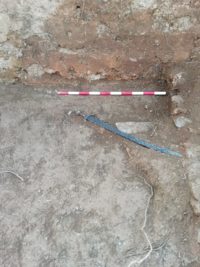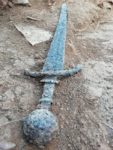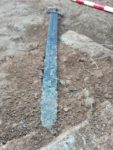 Archaeologists have unearthed a medieval sword in excellent condition at the Castle of Aín in the Spanish region of Castellón. It is three feet long with a five-inch guard and a spherical pommel. A central groove runs down the blade and two bronze rings are riveted to the hilt. Its type and archaeological context date the sword to the 14th century.
Archaeologists have unearthed a medieval sword in excellent condition at the Castle of Aín in the Spanish region of Castellón. It is three feet long with a five-inch guard and a spherical pommel. A central groove runs down the blade and two bronze rings are riveted to the hilt. Its type and archaeological context date the sword to the 14th century.
[A]rchaeologists discovered the sword under a mortar floor in a large room with a hearth and a work bench. They made the discovery while they were working on their second phase of a project aimed at strengthening the southwest sector of the castle wall. This is meant to stop the deterioration of the monument and guarantee its stability, with the hopes of making the castle a first-rate historic site.
 Perched in the craggy foothills of the Sierra del Espadán, the Castle of Aín was built in the 13th century by the Moorish rulers of the Taifa of Valencia. It would not stay in the hands of its builders for long. The taifa and castle were conquered by James I of Aragon in 1238. Relations with the conquered Moors were not peaceful, with numerous internal revolts and reconquests of the region by two different Muslim dynasties.
Perched in the craggy foothills of the Sierra del Espadán, the Castle of Aín was built in the 13th century by the Moorish rulers of the Taifa of Valencia. It would not stay in the hands of its builders for long. The taifa and castle were conquered by James I of Aragon in 1238. Relations with the conquered Moors were not peaceful, with numerous internal revolts and reconquests of the region by two different Muslim dynasties.
 After the conquest of Valencia, James I signed a treaty with his own son-in-law, the future Alfonso X of Castile, divvying up the conquered territories, but it took years for the both parties to iron out the thorny issues. A century later, with the Hundred Years’ War raging and external alliances driving conflict, the uneasy treaty of 1244 fell apart. The War of the Two Peters, in which Peter of Castile and Peter IV of Aragon duked it out over their shared border for 20 years (1356-1375) with few gains made and none kept, ended in a stalemate. The Castle of Aín took heavy damage in the fighting.
After the conquest of Valencia, James I signed a treaty with his own son-in-law, the future Alfonso X of Castile, divvying up the conquered territories, but it took years for the both parties to iron out the thorny issues. A century later, with the Hundred Years’ War raging and external alliances driving conflict, the uneasy treaty of 1244 fell apart. The War of the Two Peters, in which Peter of Castile and Peter IV of Aragon duked it out over their shared border for 20 years (1356-1375) with few gains made and none kept, ended in a stalemate. The Castle of Aín took heavy damage in the fighting.
After the unification of Castile and Aragon and the final defeat of Muslim forces in the 1500s, the castle’s strategic importance waned and there was little incentive to rebuild. Today it is a ruin. A few defensive walls still stand, a tower, a cistern, an inner drawbridge over a moat. The government of Catalonia and the Aín City Council are funding the excavations and structural reinforcements that will stabilize the dilapidated remains.